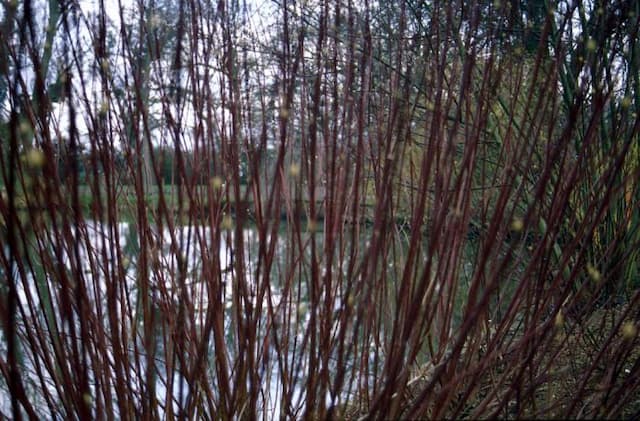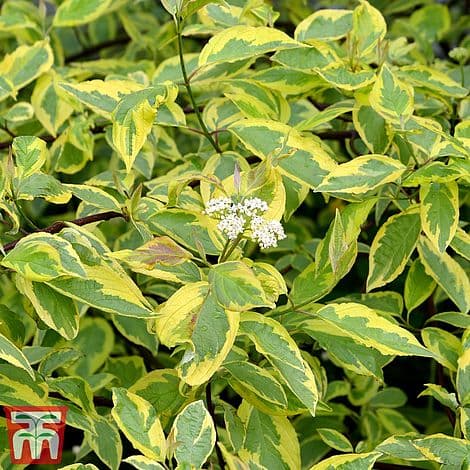Kousa dogwood Cornus kousa











ABOUT
The Kousa dogwood, known for its striking beauty, is a flowering deciduous tree that becomes a highlight in any landscape it adorns. During spring, this enchanting tree presents a spectacular floral display with its star-like white blooms that generously cover the branches, creating a cloud of white against the background of its lush green foliage. These aren't true flowers but are actually modified leaves called bracts that surround the small, insignificant yellowish-green flowers at the center. As seasons change, the foliage of Kousa dogwood undergoes a wondrous transformation. The leaves, which are oval with pointed tips and gracefully arranged along the branches, display a rich green throughout the warmer months. In autumn, they take on a vibrant show of colors, ranging from deep reds to rich purples, adding a dramatic flair to the fall palette. Kousa dogwood bears fruit that starts as a green cluster, gradually ripening into a unique pinkish-red hue. The fruit resembles a raspberry in appearance and texture, and while it's edible, it's not particularly favored for human consumption due to its bland or sometimes bitter taste. The bark of the Kousa dogwood is another distinctive feature, as it exfoliates with age to reveal a mottled pattern of tan and gray, lending great winter interest to the landscape with its jigsaw-like appearance. This plant is coveted not only for its aesthetic appeal but also for its ability to withstand various environmental challenges better than some of its counterparts, making it a cherished addition to gardens and parks.
About this plant
 Names
NamesSynonyms
Kousa Dogwood, Korean Dogwood, Chinese Dogwood, Japanese Dogwood, Kousa, Eastern Dogwood.
Common names
Benthamia kousa, Benthamidia japonica, Cynoxylon kousa, Benthamia japonica.
 Toxicity
ToxicityTo humans
Kousa dogwood (Cornus kousa) is generally considered non-toxic to humans. The fruit, which is often described as berry-like, is actually edible when ripe and is sometimes used to make wine or jelly. There is no widespread documentation of toxic effects from consuming the ripe fruit or other parts of the Kousa dogwood for humans.
To pets
Kousa dogwood is also considered non-toxic to pets, including dogs and cats. It is not commonly reported to cause poisoning in pets, and there is no well-documented evidence of Kousa dogwood causing adverse health effects. As with any non-food plant material, if pets consume large quantities of the plant, it could potentially cause mild stomach upset due to the unfamiliar material rather than toxicity.
 Characteristics
CharacteristicsLife cycle
Perennials
Foliage type
Deciduous
Color of leaves
Green
Flower color
White
Height
15-30 feet (4.5-9 meters)
Spread
15-30 feet (4.5-9 meters)
Plant type
Tree
Hardiness zones
5-8
Native area
Asia
Benefits
 General Benefits
General Benefits- Landscape Aesthetics: Japanese Dogwood is a visually appealing plant with a distinctive vase shape and layered branching, which provides ornamental value to any landscape.
- Seasonal Interest: It offers a variety of seasonal interests with white or pink flower bracts in late spring, followed by red fruit and vibrant red to purple fall foliage.
- Wildlife Attraction: The tree produces berry-like fruits that attract birds and other wildlife, providing food for them especially in the fall and winter.
- Drought Resistance: Once established, Japanese Dogwood has good drought tolerance, making it suitable for a range of conditions and reducing the need for watering.
- Low Maintenance: It generally requires minimal pruning and care once it is well-situated and established, making it convenient for gardeners of all skill levels.
- Cultural Significance: Japanese Dogwood is often used in festivals and garden displays in Asian cultures, imparting a sense of tradition and beauty.
 Medical Properties
Medical Properties- Anti-inflammatory: Cornus kousa fruit extract has been shown to have anti-inflammatory properties.
- Antioxidant: The plant contains compounds that exhibit antioxidant activity, which may help to protect cells from damage.
- Anticancer: Some studies suggest the existence of anticancer properties within the compounds found in Cornus kousa.
- Immune system modulation: There is evidence that Cornus kousa extracts can modulate the immune system, though the mechanisms are not fully understood.
- Antiviral: Extracts from the fruit have demonstrated antiviral effects against certain viruses in scientific studies.
- Antidiabetic: Cornus kousa may have potential benefits for blood sugar regulation, although robust clinical evidence is lacking.
 Air-purifying Qualities
Air-purifying QualitiesThis plant is not specifically known for air purifying qualities.
 Other Uses
Other Uses- Cornus kousa, commonly known as Kousa dogwood, can be used as a natural dye for fabrics, where the bark and leaves provide varying shades of colors and patterns.
- The wood of Kousa dogwood is hard and dense, making it suitable for crafting small items like tool handles, golf club heads, and intricate woodworking projects.
- The fruit of Kousa dogwood can be fermented to make a unique wine with a tropical, fruity flavor different from traditional grape wines.
- Kousa dogwood is sometimes planted in urban environments since it tolerates pollution and compact soil better than many other trees, helping to green up cityscapes.
- The fallen leaves of the Kousa dogwood can be collected and used as a natural mulch to improve soil health and suppress weeds in gardens.
- Creative artists and craftsmen may use the textured bark of Kousa dogwood to create natural imprints in clay or for eco-printing on sustainable textiles.
- In bonsai, the Kousa dogwood is valued for its attractive flowers and fruit, making it a popular choice for creating miniature landscapes.
- The Kousa dogwood can act as a host plant for butterfly species like the Spring Azure, providing larval food for these pollinators, contributing to biodiversity.
- During winter, the distinctive, exfoliating bark of the Kousa dogwood adds visual interest to otherwise barren landscapes, enhancing the aesthetic of winter gardens.
- The fruits of the Kousa dogwood, while not commonly consumed in the West, can be made into exotic jams and preserves, offering a unique culinary experience.
Interesting Facts
 Feng Shui
Feng ShuiThe Kousa dogwood is not used in Feng Shui practice.
 Zodiac Sign Compitability
Zodiac Sign CompitabilityThe Kousa dogwood is not used in astrology practice.
 Plant Symbolism
Plant Symbolism- Prosperity: Cornus kousa, commonly known as Kousa Dogwood, often blooms prolifically, symbolizing abundance and prosperity.
- Protection: In some cultures, the Kousa Dogwood is seen as a protective entity due to its hardy nature, which can symbolize strength and defense against adversity.
- Purity: The bright white flowers of the Kousa Dogwood can represent purity and cleanliness, often associated with its crisp and clear appearance.
- Love: The delicate and attractive appearance of its flowers can symbolize love and affection; it's sometimes associated with romance.
- Endurance: Since the Kousa Dogwood is known for its ability to withstand various climates and diseases, it is often used as a symbol of endurance and resilience.
 Water
WaterFor the Kousa dogwood, it is essential to maintain moist but not soggy soil. Watering should be done deeply about once a week, but frequency may vary depending on climate and soil conditions. During the growing season, a good rule of thumb is to provide one inch of water weekly, which equates to about 0.623 gallons for each square foot if you're watering a specific area around the tree. During hot, dry spells, you might need to water twice a week. In the winter, reduce watering as the tree is dormant and requires less moisture.
 Light
LightThe Kousa dogwood thrives in full sun to part shade. It is best positioned in a spot where it can receive at least four to six hours of direct sunlight daily; however, it also appreciates some afternoon shade, especially in warmer climates. Providing the right balance of light helps encourage better flowering and keeps the tree healthy.
 Temperature
TemperatureThe Kousa dogwood prefers temperate climates and can typically handle temperatures as low as -10 to -20 degrees Fahrenheit for short periods, with the ideal temperature range for robust growth being between 60 and 75 degrees Fahrenheit. Hotter temperatures above 85 degrees Fahrenheit may stress the plant, especially if it is exposed to direct sunlight without adequate moisture.
 Pruning
PruningThe Kousa dogwood benefits from pruning to remove dead or broken branches, maintain shape, and encourage healthy growth. The best time for pruning is late winter or early spring, before the new growth starts. Light pruning can be done any time of the year if necessary, but heavy pruning should be reserved for the dormant season to avoid stress to the tree.
 Cleaning
CleaningAs needed
 Soil
SoilKousa Dogwood prefers a well-draining, fertile soil blend with a mix of loam, peat moss, and sand, ensuring adequate moisture retention and root aeration. The recommended soil pH for Kousa Dogwood is slightly acidic to neutral, ranging from 5.5 to 7.0.
 Repotting
RepottingKousa Dogwoods are typically landscape plants and do not require frequent repotting. They should be replanted only if they outgrow their space or need soil amendment, which is relatively infrequent.
 Humidity & Misting
Humidity & MistingKousa Dogwood thrives best in moderate to high humidity levels; however, they are quite adaptable and can tolerate lower humidity environments when grown outdoors.
 Suitable locations
Suitable locationsIndoor
Place near bright window; ensure moderate humidity.
Outdoor
Full sun to partial shade; protect from harsh wind.
Hardiness zone
5-8 USDA
 Life cycle
Life cycleCornus kousa, commonly known as Kousa dogwood, begins its life as a seed which germinates in spring after a period of cold stratification. The seedling emerges and develops into a young plant with characteristic opposite, simple leaves. As the plant matures, it experiences vegetative growth each year, forming a sturdy trunk and branching pattern. After a few years, typically when the tree is 4-7 years old, it reaches reproductive maturity and starts to produce white to pinkish bracts in late spring, surrounding small clusters of yellowish-green flowers which are bee-pollinated. Following pollination, the flowers develop into globose pink to red compound berry-like fruits which ripen in late summer to fall and provide food for birds and other wildlife. The Kousa dogwood can live for many years, undergoing cycles of growth, flowering, and fruiting, with some trees living several decades under optimal conditions.
 Propogation
PropogationPropogation time
Late winter
The most popular method of propagation for Cornus kousa, commonly known as Kousa dogwood, is through seed collection and sowing. Propagation from seed typically begins in autumn after the fruits have fully ripened. The flesh of the fruit is removed to reveal the seeds, which are cleaned and then stratified. Stratification involves chilling the seeds for 90 to 120 days at temperatures of 34-40 degrees Fahrenheit (1-4 degrees Celsius) to break their dormancy. After stratification, the seeds are sown in a cold frame or outdoor seedbed in spring, placed roughly half an inch deep into well-draining soil. Germination can be slow and irregular, often taking one to three seasons. During this period, consistent moisture and protection from extreme conditions are critical for the growth of healthy seedlings.









